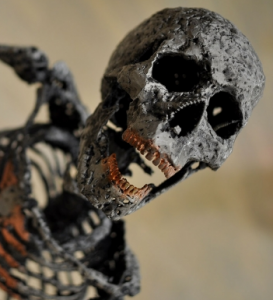Up until yesterday, everything I knew about grave robbing I learned from The Bodysnatcher (1945) http://www.imdb.com/title/tt0037549/ (an enjoyable thriller that was the last movie to feature both Karloff and Lugosi)Then I read Scott Carney’s work on the Bone Trade from India.
Scott Carney’s Blog
His piece in Wired
His piece on NPR
The guy really did his research, from the bizarrely fascinating process used to create world-class medical skeletons, to the (post)colonial economics of the business to the laws that supposedly limit the trade today. He wore out shoe leather, knocked on doors and saw and touched stuff that I suppose I’d rather not see or touch. This is journalism at its best, vital but not lurid though slightly off-beat, focused on the humans involved. The centuries old traffic in human skeletons was finally banned in India after one dealer started selling child skeletons in great quantities, quantities that could only have been acquired by murder. Understandably, folks got upset, VERY upset even attacking foreigners suspected of being involved. But wouldn’t the existing laws against murder have been enough to address this problem? Was it primarily people from the other castes upset at the financial boon?
What the reaction suggests to me is an underlying set of values and fears related to human remains. If I understand correctly, Hinduism considers dead bodies to be unclean, hence their disposal is relegated to the lowest castes. Christianity by contrast with its insistence on some form of bodily resurrection has tended to nearly venerate human remains, lest there not be enough “left” to be resurrected. (I have heard that the decay of remains is enough of a theological problem that at least one sect determined the minimum requirements for bodily resurrection were that the skull and both femurs be in tact. Allegedly, this determination somehow related to the skull and crossed bones of pirate and Masonic symbology.) Bones are also used, I think, by some forms of Buddhism to indicate the transient, illusory essence of reality. But the contrasting value system posed in these articles is the enlightened practices of Western medicine and education. And of course, good old fashioned economic value. The black market nature of this economy has helped prices rise greatly.
The final thing that I was left wondering about was how many folks die in India during any given year. It surely has to be enough to supply all the medical schools that want them, doesn’t it? Perhaps I’m naive as to the real scope of this market. The industry also sounds like a mature one, where a fully manufactured product is exported, in contrast to a more colonial system where raw materials are exported to be refined in foreign factories with the products re-imported. The only way the ban makes secular sense to me is if India wants to stock its medical schools first before supplying the rest of the world.
Anything that can spark such trains of thought is definitely worth reading, especially you’re intrigued by the idea of grave robbing.

